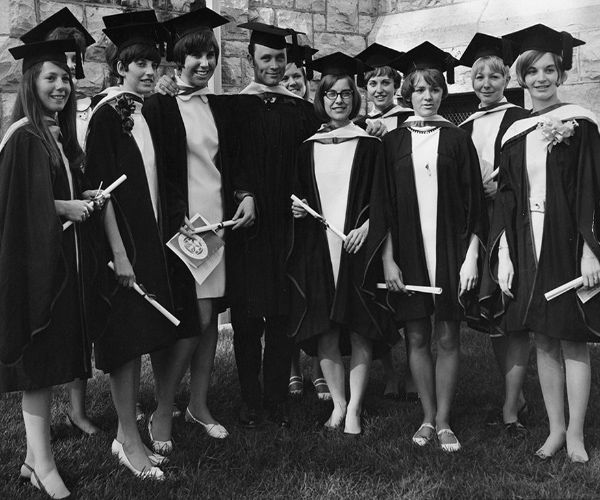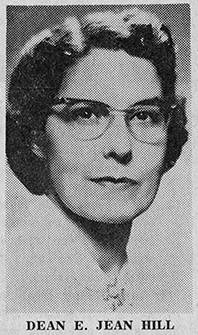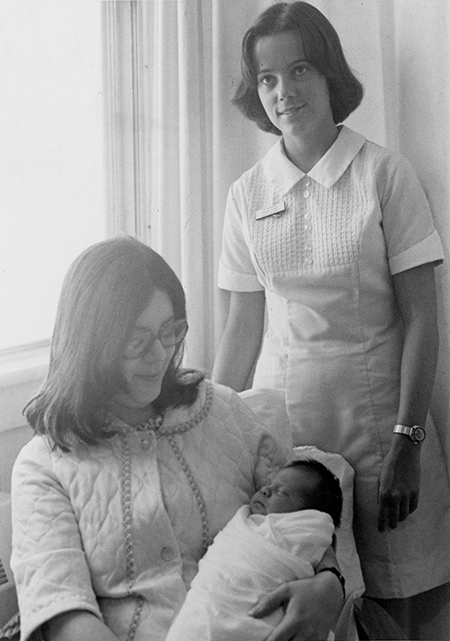![Nursing students [photo of nursing students]](/encyclopedia/sites/qencwww/files/uploaded_images/n/nursing/FA010_SCHOOL_OF_NURSING2_001.jpg)
The first nursing courses at Queen's were offered in 1941 and the School of Nursing was established shortly afterwards in response to the growing wartime demand for nurses (see Wartime at Queen's).
The first director of the school was Dorothy Riches, a distinguished nurse who had been matron-in-chief of the Royal Canadian Army Medical Corps.
It wasn’t until the mid-19th century that nursing emerged as a recognizable profession. The 20th century brought change. In the First World War, nurses from Kingston General Hospital joined medical staff from Queen’s to form field hospital and ambulance units in Europe and Egypt.
In 1929, the Canadian Nurses Association was formed amidst pressure to align nursing training with increasingly sophisticated medical knowledge. In particular, it was argued that a nurse’s hospital training should be integrated with academic education offered by universities in such fields as biology and chemistry.

In 1941, Queen’s opened a School of Nursing, opting for a non-integrated, five-year Bachelor of Nursing Science degree that sandwiched two years of university undergraduate study in between three years of on-site hospital training. The university thus had only partial control over the accreditation of those emerging from the program. The school was not considered a faculty and was headed by a director.
New leadership, new program

In the post-war, ambitious and increasingly well-qualified directors of the school — Dorothy Riches, Jenny Weir, Evelyn Moulton and Margaret Mooney — pushed hard for a program that better reflected the expanded role of the nurse as a health professional. At the same time, the old hospital nursing schools went into steep decline, unable to provide the breadth of knowledge needed by a modern nurse.
In 1974, after graduating 3,037 nurses over 88 years, the KGH school closed. By then, Queen’s was well positioned to take up the slack, guided by its director Jean Hill and backed by a progressive Dean of Medicine, Harry Botterell. In 1969, Queen’s finally launched an integrated four-year BNSc program that blended hospital training with classroom instruction in disciplines ranging from anatomy to psychology.
The emergence of the modern nurse at Queen’s was crystalized in 1977 with the appointment of Dr. Alice Baumgart, with a PhD in behavioural science, as dean. When Dean Baumgart moved up to a vice-principalship role in 1989, Rita Maloney was appointed dean.

Nurses now became part of medical teams — doctors, rehabilitation specialists and nurses all worked together, side by side. Outreach programs that saw nurse trainees gain clinical training in hospitals extended a 1965 initiative that sent Queen’s nurses to a northern Ontario community hospital in Moose Factory.
Students in the school now took to showing their spirit. Their uniforms were replaced by less formal attire. A blue Q on the sleeve denoted their status while training in the wards, and while on the street they sported blue Queen’s jackets emblazoned with “Nursing” on the back. And for a program long exclusively female, men had started to apply to the school.
In 1998, Queen’s Schools of Medicine, Nursing, and Rehabilitation Therapy amalgamated into the Faculty of Health Sciences.
Learn more about the School of Nursing...